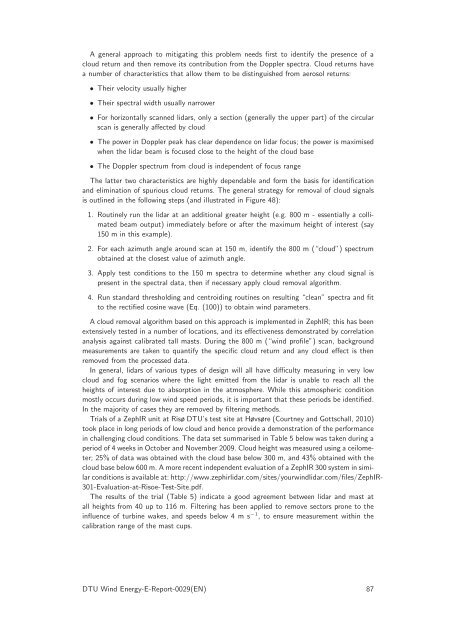Publishers version - DTU Orbit
Publishers version - DTU Orbit
Publishers version - DTU Orbit
You also want an ePaper? Increase the reach of your titles
YUMPU automatically turns print PDFs into web optimized ePapers that Google loves.
A general approach to mitigating this problem needs first to identify the presence of a<br />
cloud return and then remove its contribution from the Doppler spectra. Cloud returns have<br />
a number of characteristics that allow them to be distinguished from aerosol returns:<br />
• Their velocity usually higher<br />
• Their spectral width usually narrower<br />
• For horizontally scanned lidars, only a section (generally the upper part) of the circular<br />
scan is generally affected by cloud<br />
• The power in Doppler peak has clear dependence on lidar focus; the power is maximised<br />
when the lidar beam is focused close to the height of the cloud base<br />
• The Doppler spectrum from cloud is independent of focus range<br />
The latter two characteristics are highly dependable and form the basis for identification<br />
and elimination of spurious cloud returns. The general strategy for removal of cloud signals<br />
is outlined in the following steps (and illustrated in Figure 48):<br />
1. Routinely run the lidar at an additional greater height (e.g. 800 m - essentially a collimated<br />
beam output) immediately before or after the maximum height of interest (say<br />
150 m in this example).<br />
2. For each azimuth angle around scan at 150 m, identify the 800 m (“cloud”) spectrum<br />
obtained at the closest value of azimuth angle.<br />
3. Apply test conditions to the 150 m spectra to determine whether any cloud signal is<br />
present in the spectral data, then if necessary apply cloud removal algorithm.<br />
4. Run standard thresholding and centroiding routines on resulting “clean” spectra and fit<br />
to the rectified cosine wave (Eq. (100)) to obtain wind parameters.<br />
A cloud removal algorithm based on this approach is implemented in ZephIR; this has been<br />
extensively tested in a number of locations, and its effectiveness demonstrated by correlation<br />
analysis against calibrated tall masts. During the 800 m (“wind profile”) scan, background<br />
measurements are taken to quantify the specific cloud return and any cloud effect is then<br />
removed from the processed data.<br />
In general, lidars of various types of design will all have difficulty measuring in very low<br />
cloud and fog scenarios where the light emitted from the lidar is unable to reach all the<br />
heights of interest due to absorption in the atmosphere. While this atmospheric condition<br />
mostly occurs during low wind speed periods, it is important that these periods be identified.<br />
In the majority of cases they are removed by filtering methods.<br />
Trials of a ZephIR unit at Risø <strong>DTU</strong>’s test site at Høvsøre (Courtney and Gottschall, 2010)<br />
took place in long periods of low cloud and hence provide a demonstration of the performance<br />
in challenging cloud conditions. The data set summarised in Table 5 below was taken during a<br />
periodof4weeksinOctoberandNovember2009.Cloudheightwasmeasuredusingaceilometer;<br />
25% of data was obtained with the cloud base below 300 m, and 43% obtained with the<br />
cloudbasebelow600m.AmorerecentindependentevaluationofaZephIR300systeminsimilarconditionsisavailableat:http://www.zephirlidar.com/sites/yourwindlidar.com/files/ZephIR-<br />
301-Evaluation-at-Risoe-Test-Site.pdf.<br />
The results of the trial (Table 5) indicate a good agreement between lidar and mast at<br />
all heights from 40 up to 116 m. Filtering has been applied to remove sectors prone to the<br />
influence of turbine wakes, and speeds below 4 m s −1 , to ensure measurement within the<br />
calibration range of the mast cups.<br />
<strong>DTU</strong> Wind Energy-E-Report-0029(EN) 87

















